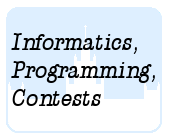Подразделы
Другие разделы
| 1935. Order |
| 1936. Malcolm |
| 1937. Aerodrom |
| 1939. Processor |
| 1940. Walnut roll |
| 1941. Essay |
| 1942. Voyager |
| 1943. Infection |
Дата и время
29/12/2025 13:51:08
 1938. Herkabe
1938. Herkabe
 Herkabe
Herkabe
 Комбинаторика, теория Пойа
Комбинаторика, теория ПойаБор
Олимпиадные задачи на английском языке

| 19/07/2013 | Лето 2013-13 (D) |
Ограничения: время – 1s/2s, память – 64MiB Ввод: input.txt или стандартный ввод Вывод: output.txt или стандартный вывод 
Послать решение Blockly Посылки Темы Где Обсудить (0)
Teacher Herkabe has decided to rank his students again. This time, he wants his list to also be
aesthetically pleasant, so he has decided that similar names (those beginning with the same letter or
sequence of letters) must be close to one another on the list. Therefore, he has devised the following
rule:
For every two names on the list that begin with the same letter sequence, all names between
them on the list must also begin with that letter sequence.
For example, consider the names MARTHA and MARY (characters from a beautiful story). They both
begin with the sequence MAR, so names beginning with the same sequence (like MARCO and
MARVIN) can appear in between (but not MAY, for example).
Notice that the lexicographically sorted ordering always satisfies this rule, but it is by no means the only
valid ordering. Your task is determining how many different orderings satisfy the rule, i.e. how many
options teacher Herkabe has for his ranking list.
The first line of input contains the positive integer `N` (`3\ ≤\ N\ ≤\ 3000`), the number of names.
Each of the following `N` lines contains a single name: a sequence of between 1 and 3000 (inclusive)
uppercase English letters. The names are distinct and given in no particular order.
The first and only line of output must contain the required number of possible ranking lists, modulo
`1\ 000\ 000\ 007`.
Sample Input #1
3 IVO JASNA JOSIPA
Sample Output #1
4
Sample Input #2
5 MARICA MARTA MATO MARA MARTINA
Sample Output #2
24
Sample Input #3
4 A AA AAA AAAA
Sample Output #3
8

 Начало
Начало